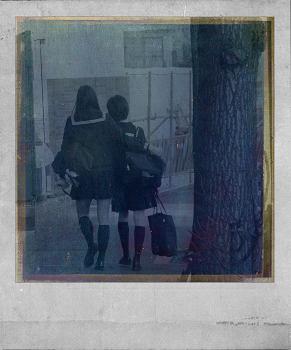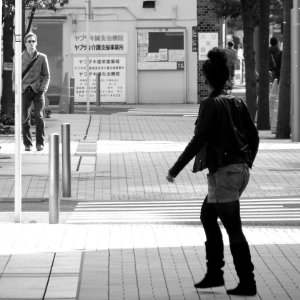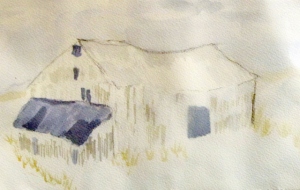|
We’ve had some wonderful art in our pages during our Year of Flash and Al McDermid and Guy Yasko have been featured regularly.
So we take some time here to pay tribute. We asked each of them to tell us a little more about their process, inspiration, and methods on this page. Below you’ll see why we’ve come to appreciate McDermid’s photography and Yasko’s watercolors in our pages so much, and you’ll perhaps see the world from their perspectives, just a little. |
|
You have lived abroad for a good part of your life. Tell us how living somewhere other than where you were born has influenced your art.
If you include Hawaii, which I do, I’ve live all but 4 or 5 years of adult life abroad, but in terms of my photographs and collages, I cannot attest to any notable direct influence of this essential rootlessness. I could probably see myself as an outsider if I chose to (I haven’t been part of an ethnic majority since I left the U.S. Navy at 26), but I don’t. I do have difficulty thinking in terms of ‘my country’ as other people seem to; in fact, even mildly nationalistic and/or patriotic sentiments baffle me, as expressed in the following senryu (haiku that relates to human nature):
Fourth of July
the fireworks leave me
ambivalent
If I can claim any ‘foreign’ influence at all, it comes from Japanese art, my favorite of which is haiku. I enjoy the brevity of language embodied in haiku, and try to achieve this same ‘crispness’ in all my writing. Sometimes I even succeed. Looking through my photos and collages that I favor, I see that the most appealing of these also embody some of this brevity.
Where have you felt most at home, and where has your art felt most at home?
I know I just said that I choose not to see myself as an outsider, but I can’t recall where I’ve ever felt at home. Certainly not here in Japan, where who is inside, and who is not, is clearly defined; nor in Hawaii, where the same principle mostly applies. That’s 30 years of my so-called adult life.
Where is my art most at home? I could probably answer that better if my art had any kind of circulation. My photographic range is varied, but leans toward simple beauty, so I think the best place for my art would be on the walls of private homes, in those unobtrusive spots that need a little something extra, just a touch of accent.
As an aside, I want to add that I don’t understand the wide appeal of the grotesque, or the idea that art must say something drastic—in a museum, or at art shows, sure, but in one’s home? To look at every day? It’s obviously appealing to some, but such art is perhaps the polar opposite of what I like, and what I would like to achieve. |
 |
|
Are there any artist in particular, or a particular style, that has affected the way you ‘see’ the world and convey it in your art?
I have no education in art or photography, but at one time I wanted to be an oil painter and my favorite artist was (and still is) John Singer Sergeant, principally for what he obviously understood about light. I’ve pursued photography for only two years now, and have experimented a great deal within the limits of my equipment (a Canon PowerShot, which is significantly better than a compact, but nowhere close to an SLR), but again, the photos I most like show an obvious concern for light, shadow, color balance. As my good friend Stephen Paschal, a professional oil painter, noted, ‘Your best photos are obviously shot with a painter’s eye’. |
 |
 |
Do you strive to capture something specific in your art, and if so, what? What, in your opinion, can art best express?
For the last two years, in terms of photography, I’ve mostly been just goofing around, with no particular vision; my writing, though I’ve been at it longer, is not much different. Glance at my gallery on Deviant Art (mcdermid.deviantart.com), and you’ll see that I’m kind of all over the place, except that I seldom write non-fiction.I’m settling down some and have recently become more serious about haiku (I now write at least 2 or 3 a week). Within the haiku tradition there is the idea of the ‘haiku moment’, a nearly Zen-like moment of clarity in which the poet observes a scene so clearly as to be able to express it within the limits of haiku; such haiku are typically multi-layered. I want to capture such moments in my poetry, and with my camera.
One of our favorite pieces by you is “The Connection” in Week 29. Tell us how you take these street scenes. Do you wait for something to happen, or do you snap repeatedly and see what crosses your lens, or something in between?
Street photography doesn’t relate at all to what I just said about painterly photos, but is very much about capturing those ‘Zen moments’ that occur all the time, every day (I even have one shot with the title, ‘A Zen Moment’). There are some street photographers who have ‘blinds’ in potentially good areas, but my method is a bit more relaxed.
Sometimes I’ll go to an area where I can assume to get some good shots (Harajuku, for example), but I’ve been able to get my best street shots, like ‘The Connection’, by simply having my camera out. I don’t really think about the shots at all; I see something, point the camera, and shoot. Sometimes, I’m not even looking, and invariably, I delete many more shots than I keep. My camera does offer one advantage for street shooting in that it has a swivel view screen that allows me to hold the camera at my side and still see what I’m shooting; I’ve shots of people looking straight into the camera, but appear to not know I’m shooting them. |
|
You have lived abroad for a good part of your life. Tell us how living somewhere other than where you were born has influenced your art.
I expect that most of the influence is unconscious. That said, I do see an outsider’s perspective in my work. That angle is fairly constant even if I move around physically.I think reading and writing Chinese characters also has an effect. It’s a kind of drawing, and the discipline of brush strokes carries over into less abstract forms of expression.
Where have you felt most at home, and where has your art felt most at home?
I feel most at home in Japan. I don’t know about my art. There are some things such as pictures of animals for new year’s cards or seasonal greetings that fit best in a Japanese context. I wouldn’t do such things had I not lived in Japan. I also like sumi-e and that seems very Asian, but then if I’m drawing a rotting downtown in the American midwest, it seems a world away from a Chinese or Japanese brush drawing. |
 |
|
Are there any artist in particular, or a particular style, that has affected the way you ‘see’ the world and convey it in your art?
I come from a long line of artists on my mother’s side. I’ve learned the most technique from my mother, who was also very influenced by Japan. We always had a few of my grandfather’s paintings around, and I’ve always liked the way he was able to express emotions in landscape.
I learned a lot — but not nearly enough — from John Weber and Mitchell Caton, both Chicago muralists. |
 |
 |
Do you strive to capture something specific in your art, and if so, what? What, in your opinion, can art best express?
I’m drawn to objects and views more than specific messages. In a rather conventional way, I use objects and scenes to structure my painting and drawing. I can’t always predict what will result.
We love the painting “Center St.” from Week 35. You say it’s about your own home town, but there’s something more universal about it. What do you think makes something so specific speak to so many viewers?If nothing else, “Center St.” the painting shows a haunting. We are fascinated by ruins, by the haunting of present by past.
Also: We were intrigued by how you describe the way you finished this piece: by *not* finishing it. Tell us, when do you know a painting is finished, and what does it mean to be *finished*?
It depends on the medium. Watercolor demands great restraint, because there’s no going back. In watercolor, I stop when going further will muddy the tones, when going further will take away too much light.
Sumi-e is much the same. I stop when the lines convey a message. It may not be the message I was consciously trying to express and the lines may only suggest or imply, but I feel that is good enough. |
Return to Home Page
|


Very informative, and interesting how you’ve both lived so much in Japan.
Al, I think the ‘friends forever’ image here is my favorite by you. And I can see your point about the haiku. I think of really well done flash being like a haiku, capturing the essence of a moment, emotion, or feeling.
Guy,Your watercolors are so beautiful. I’ve dabbled a bit with drawing and painting, but I’ve never been able to master that restraint when it comes to watercolor. I like how you talk about the absence of the paint creating light, almost like your painting with the empty space.
Thank you for sharing.
May 12, 2011 at 6:29 pm
Thank you, ganymeder. I’m flattered.
Al:
I have to say, i like your stuff even more the second go around!
May 12, 2011 at 10:01 pm
Just wonderful: the words of Guy, his amazing pictures that have graced these 52/250 walls for a year, his take on things and life. Thanks for being so candid, Guy, and for all you’ve contributed to this project.
Best, Susan
May 16, 2011 at 4:48 pm
Al’s work is gorgeous, and I found his text on Japan marvelous and interesting. I’m quite in love with “Friends Forever.” Thanks for the great images this past year!
Cheers! Susan
May 16, 2011 at 4:52 pm